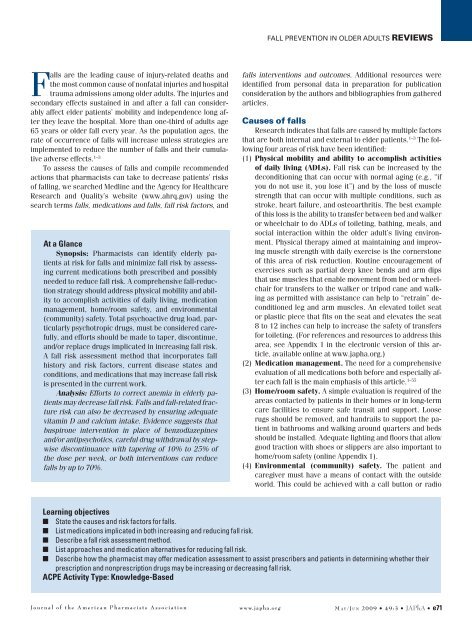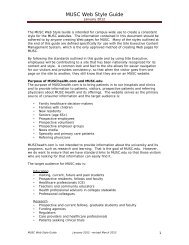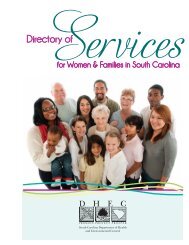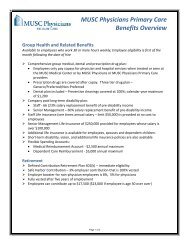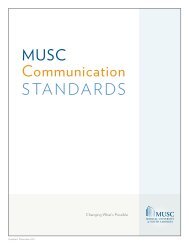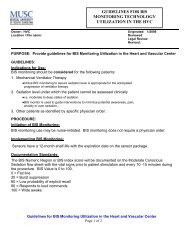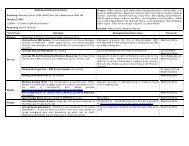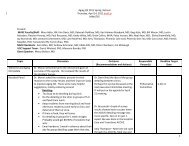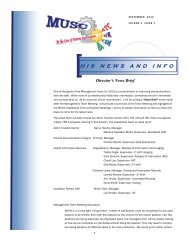<strong>Fall</strong> prevention <strong>in</strong> older adults Reviews<strong>Fall</strong>s are <strong>the</strong> lead<strong>in</strong>g cause of <strong>in</strong>jury-related deaths and<strong>the</strong> most common cause of nonfatal <strong>in</strong>juries and hospitaltrauma admissions among older adults. The <strong>in</strong>juries andsecondary effects susta<strong>in</strong>ed <strong>in</strong> and after a fall can considerablyaffect elder patients’ mobility and <strong>in</strong>dependence long after<strong>the</strong>y leave <strong>the</strong> hospital. More than one-third of adults age65 years or older fall every year. As <strong>the</strong> population ages, <strong>the</strong>rate of occurrence of falls will <strong>in</strong>crease unless strategies areimplemented to reduce <strong>the</strong> number of falls and <strong>the</strong>ir cumulativeadverse effects. 1–3To assess <strong>the</strong> causes of falls and compile recommendedactions that pharmacists can take to decrease patients’ risksof fall<strong>in</strong>g, we searched Medl<strong>in</strong>e and <strong>the</strong> Agency <strong>for</strong> HealthcareResearch and Quality’s website (www.ahrq.gov) us<strong>in</strong>g <strong>the</strong>search terms falls, medications and falls, fall risk factors, andAt a GlanceSynopsis: Pharmacists can identify elderly patientsat risk <strong>for</strong> falls and m<strong>in</strong>imize fall risk by assess<strong>in</strong>gcurrent medications both prescribed and possiblyneeded to reduce fall risk. A comprehensive fall-reductionstrategy should address physical mobility and abilityto accomplish activities of daily liv<strong>in</strong>g, medicationmanagement, home/room safety, and environmental(community) safety. Total psychoactive drug load, particularlypsychotropic drugs, must be considered carefully,and ef<strong>for</strong>ts should be made to taper, discont<strong>in</strong>ue,and/or replace drugs implicated <strong>in</strong> <strong>in</strong>creas<strong>in</strong>g fall risk.A fall risk assessment method that <strong>in</strong>corporates fallhistory and risk factors, current disease states andconditions, and medications that may <strong>in</strong>crease fall riskis presented <strong>in</strong> <strong>the</strong> current work.Analysis: Ef<strong>for</strong>ts to correct anemia <strong>in</strong> elderly patientsmay decrease fall risk. <strong>Fall</strong>s and fall-related fracturerisk can also be decreased by ensur<strong>in</strong>g adequatevitam<strong>in</strong> D and calcium <strong>in</strong>take. Evidence suggests thatbuspirone <strong>in</strong>tervention <strong>in</strong> place of benzodiazep<strong>in</strong>esand/or antipsychotics, careful drug withdrawal by stepwisediscont<strong>in</strong>uance with taper<strong>in</strong>g of 10% to 25% of<strong>the</strong> dose per week, or both <strong>in</strong>terventions can reducefalls by up to 70%.falls <strong>in</strong>terventions and outcomes. Additional resources wereidentified from personal data <strong>in</strong> preparation <strong>for</strong> publicationconsideration by <strong>the</strong> authors and bibliographies from ga<strong>the</strong>redarticles.Causes of fallsResearch <strong>in</strong>dicates that falls are caused by multiple factorsthat are both <strong>in</strong>ternal and external to elder patients. 1–3 The follow<strong>in</strong>gfour areas of risk have been identified:(1) Physical mobility and ability to accomplish activitiesof daily liv<strong>in</strong>g (ADLs). <strong>Fall</strong> risk can be <strong>in</strong>creased by <strong>the</strong>decondition<strong>in</strong>g that can occur with normal ag<strong>in</strong>g (e.g., “ifyou do not use it, you lose it”) and by <strong>the</strong> loss of musclestrength that can occur with multiple conditions, such asstroke, heart failure, and osteoarthritis. The best exampleof this loss is <strong>the</strong> ability to transfer between bed and walkeror wheelchair to do ADLs of toilet<strong>in</strong>g, bath<strong>in</strong>g, meals, andsocial <strong>in</strong>teraction with<strong>in</strong> <strong>the</strong> older adult’s liv<strong>in</strong>g environment.Physical <strong>the</strong>rapy aimed at ma<strong>in</strong>ta<strong>in</strong><strong>in</strong>g and improv<strong>in</strong>gmuscle strength with daily exercise is <strong>the</strong> cornerstoneof this area of risk reduction. Rout<strong>in</strong>e encouragement ofexercises such as partial deep knee bends and arm dipsthat use muscles that enable movement from bed or wheelchair<strong>for</strong> transfers to <strong>the</strong> walker or tripod cane and walk<strong>in</strong>gas permitted with assistance can help to “retra<strong>in</strong>” deconditionedleg and arm muscles. An elevated toilet seator plastic piece that fits on <strong>the</strong> seat and elevates <strong>the</strong> seat8 to 12 <strong>in</strong>ches can help to <strong>in</strong>crease <strong>the</strong> safety of transfers<strong>for</strong> toilet<strong>in</strong>g. (For references and resources to address thisarea, see Appendix 1 <strong>in</strong> <strong>the</strong> electronic version of this article,available onl<strong>in</strong>e at www.japha.org.)(2) <strong>Medication</strong> management. The need <strong>for</strong> a comprehensiveevaluation of all medications both be<strong>for</strong>e and especially aftereach fall is <strong>the</strong> ma<strong>in</strong> emphasis of this article. 1 –55(3) Home/room safety. A simple evaluation is required of <strong>the</strong>areas contacted by patients <strong>in</strong> <strong>the</strong>ir homes or <strong>in</strong> long-termcare facilities to ensure safe transit and support. Looserugs should be removed, and handrails to support <strong>the</strong> patient<strong>in</strong> bathrooms and walk<strong>in</strong>g around quarters and bedsshould be <strong>in</strong>stalled. Adequate light<strong>in</strong>g and floors that allowgood traction with shoes or slippers are also important tohome/room safety (onl<strong>in</strong>e Appendix 1).(4) Environmental (community) safety. The patient andcaregiver must have a means of contact with <strong>the</strong> outsideworld. This could be achieved with a call button or radioLearn<strong>in</strong>g objectives■■ State <strong>the</strong> causes and risk factors <strong>for</strong> falls.■■ List medications implicated <strong>in</strong> both <strong>in</strong>creas<strong>in</strong>g and reduc<strong>in</strong>g fall risk.■■ Describe a fall risk assessment method.■■ List approaches and medication alternatives <strong>for</strong> reduc<strong>in</strong>g fall risk.■■ Describe how <strong>the</strong> pharmacist may offer medication assessment to assist prescribers and patients <strong>in</strong> determ<strong>in</strong><strong>in</strong>g whe<strong>the</strong>r <strong>the</strong>irprescription and nonprescription drugs may be <strong>in</strong>creas<strong>in</strong>g or decreas<strong>in</strong>g fall risk.ACPE Activity Type: Knowledge-BasedJournal of <strong>the</strong> American Pharmacists Association www.japha.org M a y /Ju n 2009 • 49:3 • JAPhA • e71
Reviews <strong>Fall</strong> prevention <strong>in</strong> older adultsdevice that summons help when one is unable to ambulateor needs assistance. A cell phone kept on <strong>the</strong> patient is ano<strong>the</strong>rsimple method <strong>for</strong> lett<strong>in</strong>g caregivers know that helpis needed (onl<strong>in</strong>e Appendix 1).Comprehensive strategyA comprehensive fall-reduction strategy that addresses allfour of <strong>the</strong> above areas can be effective. However, many previousef<strong>for</strong>ts have been hampered by several factors:(1) Failure to consider all possible causes of falls, especiallymedications and <strong>the</strong> need <strong>for</strong> physical assistance to improvestrength and ambulation ability.(2) Failure to translate research <strong>in</strong>to practice, especially whenmedications are concerned. (This article concentrates onremedy<strong>in</strong>g this apparent failure.)(3) Lack of coord<strong>in</strong>ation among <strong>in</strong>terested but disparate organizationsthat support <strong>the</strong> older adult and <strong>the</strong>ir caregivers.(4) M<strong>in</strong>imization and trivialization of <strong>the</strong> issue, sometimesthrough media images cast<strong>in</strong>g older people as powerlessand pa<strong>the</strong>tic (e.g, <strong>the</strong> “I’ve fallen and I can’t get up” commercials).(5) Scarcity of approaches that are culturally sensitive and appropriate<strong>for</strong> older adults of all literacy levels. <strong>Adult</strong> daycareand senior centers, as well as assisted-liv<strong>in</strong>g and personalcare facilities, are ideal locations <strong>for</strong> tra<strong>in</strong><strong>in</strong>g bothpatients and caregivers to decrease fall risk. Onl<strong>in</strong>e Appendix1 has numerous resources that document <strong>the</strong>se factorsand can aide educational ef<strong>for</strong>ts.Numerous studies show <strong>the</strong> benefit of multifactorial fallrisk <strong>in</strong>terventions and improved outcomes with comprehensivestrategy implementation, and guidel<strong>in</strong>es <strong>for</strong> fall preventionhave been published. 35–43Psychoactive drug medication <strong>in</strong>terventions are limited by<strong>the</strong> lack of validation of currently available assessment <strong>in</strong>struments;most falls are caused by multiple risk factors that alsoshould be taken <strong>in</strong>to account but are not covered <strong>in</strong> this review(e.g., gait assessment, strength tra<strong>in</strong><strong>in</strong>g, environmental assessmentand changes). Onl<strong>in</strong>e Appendix 1 lists resources thatmay be of value <strong>in</strong> fall risk-reduction educational programs.<strong>Fall</strong> risk assessment methods<strong>Fall</strong>s <strong>in</strong> <strong>the</strong> older patient clearly lead to <strong>in</strong>creased healthcare use and decreased functional status. 1 A fall risk <strong>in</strong>dexbased on <strong>the</strong> number of chronic disabilities has been advocated.2 Earlier studies of fall factors, <strong>in</strong>cidence, and morbidityfound that those who susta<strong>in</strong>ed falls were more likely to be suffer<strong>in</strong>gfrom dementia, were prescribed more sedat<strong>in</strong>g drugs,and had abnormal balance and gait compared with age- andsex-matched control patients. In addition, orthostasis, arthritides,<strong>in</strong>cont<strong>in</strong>ence, and strokes were more prevalent <strong>in</strong> <strong>the</strong>sepatients. 3–5 A fall risk assessment that <strong>in</strong>corporates psychotropicand o<strong>the</strong>r psychoactive medications has been developed(Figure 1), 6 and medications implicated <strong>in</strong> falls have beendescribed. 7 A multifactorial <strong>in</strong>tervention to reduce <strong>the</strong> risk offall<strong>in</strong>g among <strong>the</strong> elderly liv<strong>in</strong>g <strong>in</strong> <strong>the</strong> community has been developed.8Basic patient assessment method <strong>for</strong> pharmacistsThe pharmacist may benefit from us<strong>in</strong>g a universal problem-orientedmedical record (POMR) or medication <strong>the</strong>rapymanagement (MTM) method to assess and recommendchanges <strong>in</strong> <strong>the</strong> patients’ drug regimen 51 as well as physical andlaboratory assessments that may be needed to optimize drug<strong>the</strong>rapy. We developed an onl<strong>in</strong>e 15-hour (1.5–cont<strong>in</strong>u<strong>in</strong>g educationunit) course on physical and laboratory assessment of<strong>the</strong> older adult; it is available at www.rxugace.com or www.shca-ga.org.The POMR method has four steps:(1) Per<strong>for</strong>m a history of patients problems, <strong>in</strong>clud<strong>in</strong>g past andcurrent diagnoses, conditions, all medications, past operations,immunizations, and adverse drug reactions, as wellas abnormal physical and lab f<strong>in</strong>d<strong>in</strong>gs that need to be addressed.Some practitioners prefer to group problems byorgan system (e.g., cardiovascular, endocr<strong>in</strong>e, pulmonary,gastro<strong>in</strong>test<strong>in</strong>al, genitour<strong>in</strong>ary, neuropsychiatric, dermatologic).(2) Match <strong>the</strong> medications found with <strong>the</strong> problems list; actionmay be needed if <strong>the</strong>re are medications or problems that donot match or are not addressed.(3) Assess how adequately each problem is be<strong>in</strong>g addressedby us<strong>in</strong>g <strong>the</strong> SOAP method <strong>for</strong> each problem: subjective (S)or compla<strong>in</strong>ts of <strong>the</strong> patient; objective (O) or th<strong>in</strong>gs thatcan be assigned numerical values such as physical f<strong>in</strong>d<strong>in</strong>gsof <strong>the</strong> vital signs of blood pressure, pulse, respiration,and temperature and lab values; assessment (A) of S and Of<strong>in</strong>d<strong>in</strong>gs <strong>for</strong> each problem; and plan (P) <strong>for</strong> communicationof <strong>the</strong> assessment of each problem.(4) Communication of <strong>the</strong> problems that need to be addressedto <strong>the</strong> appropriate prescriber, patients and <strong>the</strong>ir caregivers,and adm<strong>in</strong>istrators responsible <strong>for</strong> <strong>the</strong> patient is <strong>the</strong>most important step of <strong>the</strong> process.The POMR process may be thought of as a part of <strong>the</strong> MTMprocess. The American Pharmacists Association (APhA) andNational Association of Cha<strong>in</strong> Drug Stores released version 2.0of an MTM service model, which can be downloaded at www.nacdsfoundation.org, and a certificate tra<strong>in</strong><strong>in</strong>g program developedby APhA and <strong>the</strong> American Society of Consultant Pharmacistsis available at www.pharmacist.com.Def<strong>in</strong>itionsPsychotropics are def<strong>in</strong>ed as anxiolytics, hypnotics, antipsychotics,and antidepressants. Psychoactives or central nervoussystem (CNS)-active agents <strong>in</strong>clude psychotropics and <strong>the</strong>prok<strong>in</strong>etic agent metoclopramide, narcotic or opioid analgesics,antipark<strong>in</strong>son agents, anticonvulsants, muscle relaxants,antihistam<strong>in</strong>es, and centrally act<strong>in</strong>g antihypertensives. 7A patient’s total psychoactive drug load is best def<strong>in</strong>edas <strong>the</strong> total number of psychotropic and o<strong>the</strong>r psychoactivemedications given on a regular (i.e., at least weekly) basis. Asneededmedications given on a less-than-weekly basis may beconsidered relevant if <strong>the</strong>ir usage occurred with<strong>in</strong> 1 week of afall and <strong>the</strong> drugs <strong>in</strong>volved were antipsychotics or longer-act<strong>in</strong>gbenzodiazep<strong>in</strong>es (BZs). 7e72 • JAPhA • 49:3 • M a y /Ju n 2009www.japha.orgJournal of <strong>the</strong> American Pharmacists Association


